The MSI Prestige 14 Evo Review: Testing The Waters Of Tiger Lake
by Brett Howse on December 17, 2020 10:00 AM EST- Posted in
- Laptops
- Intel
- MSI
- Tiger Lake
- Notebook
Graphics Performance
Intel has made a lot of strides in terms of graphics performance in a short amount of time. After languishing with integrated graphics that were adequate for 2D but no more, Intel has put a priority on graphics. Last year’s Ice Lake platform’s Gen11 graphics used the same basic graphics architecture, but increased the GPU size dramatically to 64 Execution Units on the G7 processors. For Tiger Lake, not only has that number been bumped again to 96 Execution Units (EUs), the architecture is getting a revamp as well, and thanks to the 10 nm SuperFin process, GPU frequencies are also getting a significant boost from 1100 MHz to 1350 MHz peak.
Coupled with even faster LPDDR4X-4267 memory, the GPU in the Core i7-1185G7 is far and away the most powerful GPU Intel has ever integrated into a laptop SoC. It also includes a new media block with AV1 codec decode support in hardware, and a 12-bit end-to-end video pipeline. Intel has come a long way in terms of graphics performance in just two generations. You could argue they had a long way to go of course, but it is still impressive to see this big of a jump in just two generations.
MSI will also be launching a model of the Prestige 14 Evo which includes the NVIDIA GTX 1650 in Max-Q configuration, so if you do need more GPU performance, MSI will be able to deliver.
Laptop integrated graphics were so anemic only a couple of generations ago that we were only able to test them in the most low-end games, but with AMD’s integrated Vega and now Intel Xe graphics, we will continue to broaden the tests for Ultrabooks. For today, we will start with a couple of synthetics, and then get into our laptop gaming suite.
3DMark
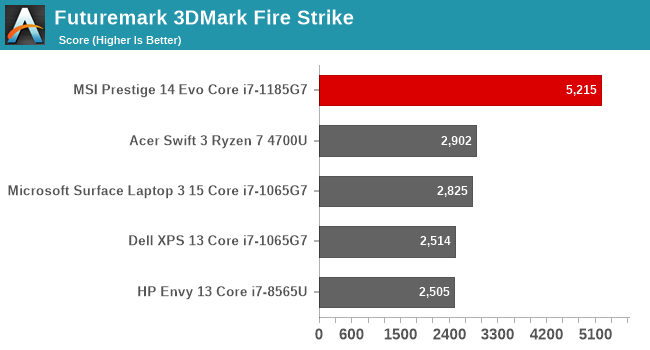
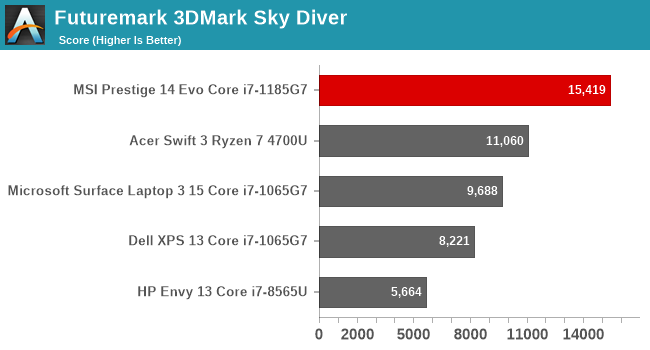


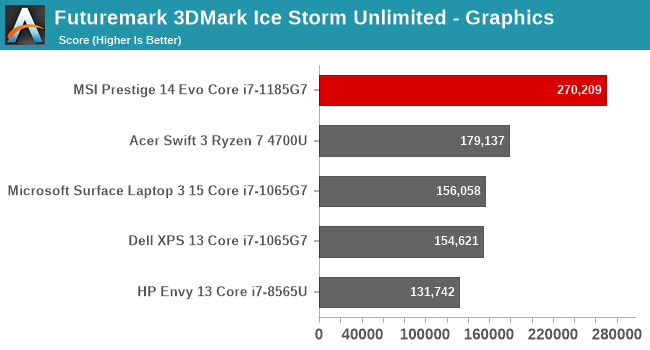
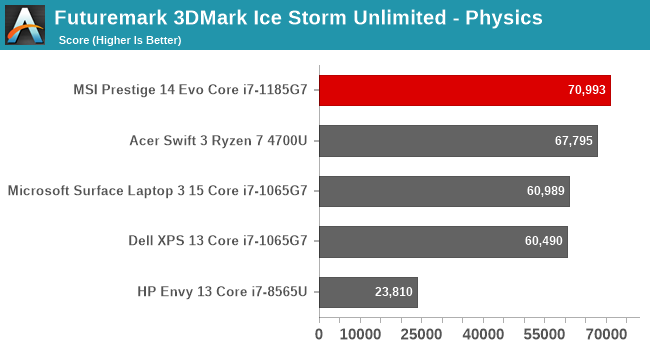
Offering a wide-array of tests with different graphical workloads, UL’s 3DMark allows for a very wide range of testing. For laptops, we test Fire Strike, Skydiver, Cloud Gate, and Ice Storm Unlimited, with the former being the most complex of the bunch, and Ice Storm Unlimited being a test that can be run on smartphones and tablets.
Intel Xe delivers. On Fire Strike, the Core i7-1185G7 in the MSI Prestige 14 Evo scores close to twice as high as the Core i7-1165G7. This test is the most complex, and therefore the one that bottlenecks on the GPU the most. The gains continue to be very strong across the board, even on the less complex tests which end up being more CPU bound. The combination of Intel Xe graphics and the Willow Cove cores showcase the gains made pretty dramatically.
GFXBench
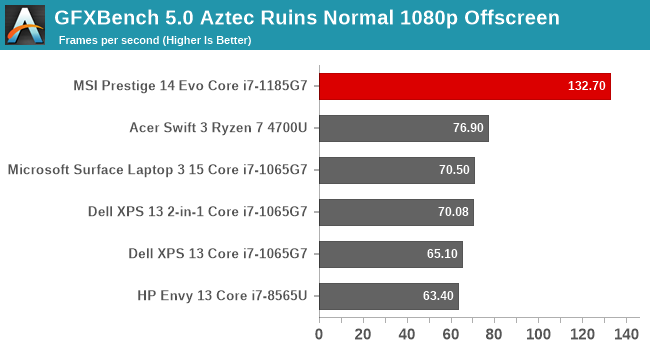
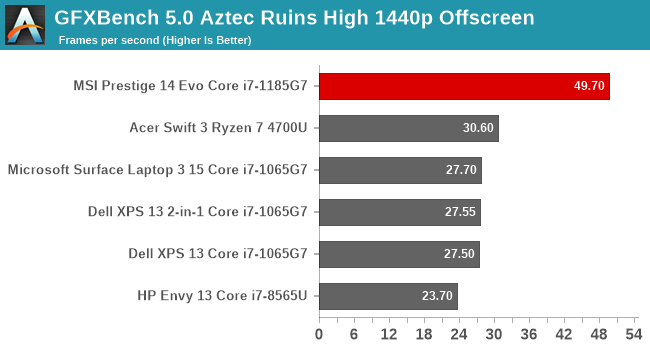
Version 5 of GFXBench revamped the test suite, and included DirectX 12 workloads of the same Aztec scenes as found in Kishonti’s smartphone / tablet offerings, but built with the native Windows API as the target. The results here are almost the same as 3DMark, with the new Intel Xe graphics almost doubling the performance of the outgoing Ice Lake systems.
Tomb Raider
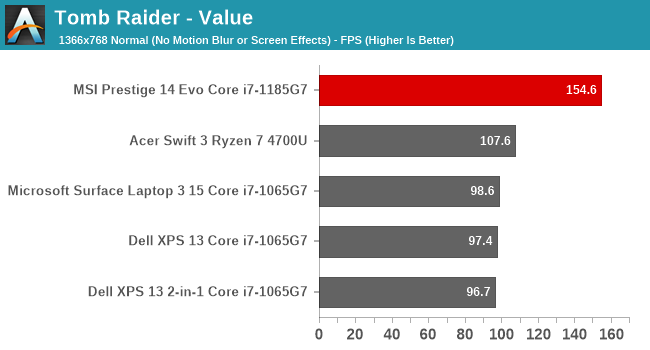
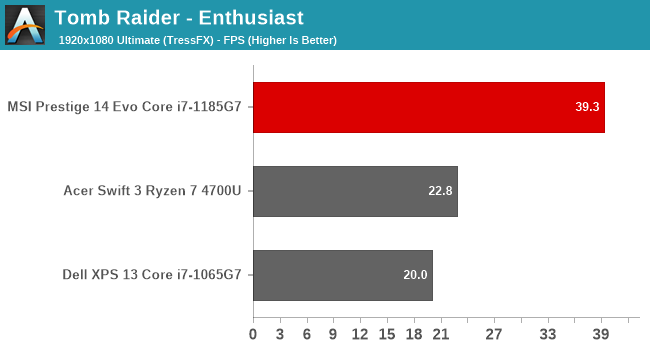
Despite being several years old now, the Tomb Raider reboot continues to be a demanding game on notebooks, especially at 1920x1080 with all of the settings turned up. 39.3 frames per second at our Enthusiast level is still less than ideal, but more than doubles the performance of last year’s Ice Lake processor.
Rise of the Tomb Raider
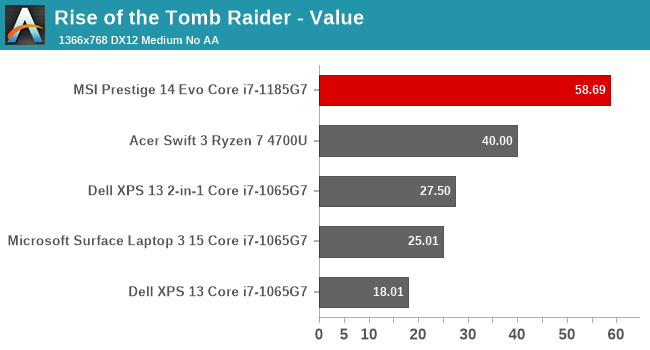
Adding a higher level of graphics, and DirectX 12 support, Rise of the Tomb Raider is a much more demanding game than the original Tomb Raider reboot. As such, we only run it at our value settings on integrated GPUs, but for the first time, the MSI Prestige 14 gets really close to the 60 FPS average framerate we are looking for, and again, more than doubles the performance of an Ice Lake processor.
Strange Brigade

Another DirectX title is Strange Brigade, which is playable on our value settings even on previous integrated graphics at around 60 FPS. The MSI Prestige smashes past that barrier on our value settings, and is 50% faster in this test than Intel’s Gen11 GPU. Attempting to play this at our Enthusiast level of settings (1920x1080 Ultra) is still not possible, as the laptop only achieved 27 FPS average, but there is enough performance here that the game doesn’t need to be played at the lowest settings.
F1 2019
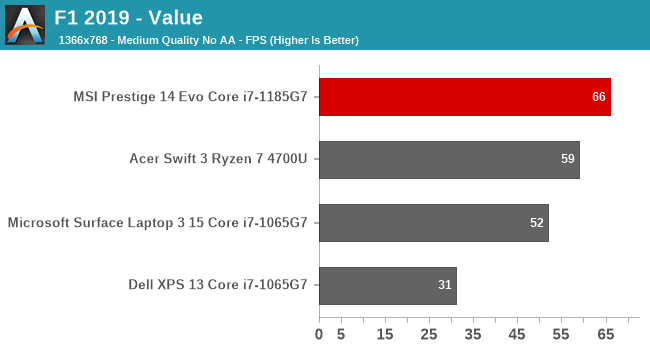
Codemasters’ F1 2019 has traditionally been a more CPU bound test, and that seems to resonate here again. Although the game was significantly faster than an Ice Lake system, it was not the 50-100% faster that it is on some other titles.
Far Cry 5
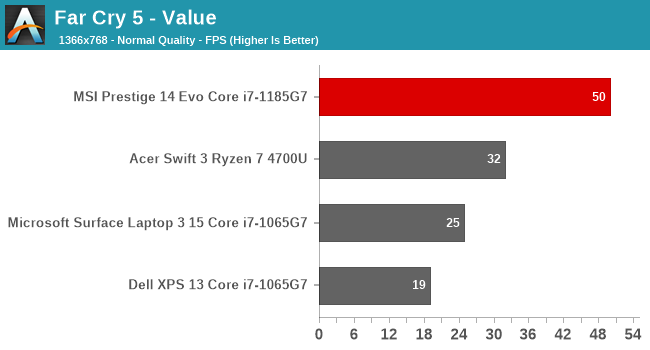
Ubisoft’s popular Far Cry series also includes a built-in benchmark, and traditionally integrated graphics have been right on the cusp of being playable. The MSI Prestige 14 is really the first device we’ve tested with integrated graphics that can actually play this top-tier FPS at reasonable framerates, once again being about double the performance of the outgoing Ice Lake SoC.
GPU Summary
After years of offering integrated graphics that were adequate for desktop work, Intel has clearly focused a lot of their resources on improving GPU performance. The new Xe graphics were up to twice as fast in real-world games than the outgoing Gen11 GPU with 64 EUs. That is very impressive. The new larger GPU wins across the board, and easily outpaces the Vega graphics found in competing AMD systems. It is an impressive achievement. With Intel moving into the dGPU space, hopefully this progress continues.


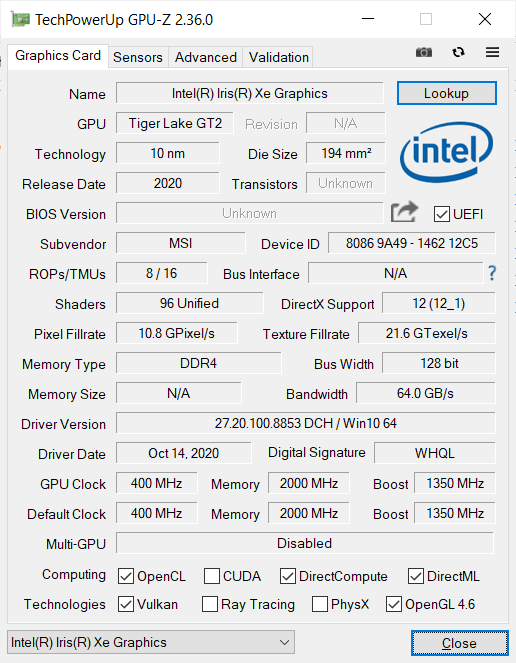








63 Comments
View All Comments
Spunjji - Friday, December 18, 2020 - link
I can accept this rationale on a device that has 2 or 3 USB 3 A ports along with the USB 2 port, but when it's the only USB A port on the device it's a poor showing. It's a bit premature to refer to any storage device not using USB-C as "legacy".Deicidium369 - Thursday, December 17, 2020 - link
Not like you would REALLY be a customer ...tipoo - Thursday, December 17, 2020 - link
Any impressions on how the Intel publicized Ryzen 10 second boost delay on battery impacts real world system responsiveness?Smell This - Thursday, December 17, 2020 - link
**The CPU runs at an all-core turbo of 4.3 GHz initially with a peak power draw of almost 52 Watts, and then settles down to a sustained 30-Watt draw for the duration with the CPU frequency...**_________________________________________________
Would be nice if AT actually identified the X-axis title and time scale.
INCREDIBLY DISAPPOINTED on how this has been presented.
Brett Howse - Thursday, December 17, 2020 - link
In what has been a difficult year for everyone, I can see how this lapse in my judgement has hurt significantly. I apologize, and have updated the offending table.lmcd - Friday, December 18, 2020 - link
This travesty will likely shake the earth to its core. Next earthquake's on you bud ;)Smell This - Friday, December 18, 2020 - link
Thanks, BrettNo worries, Mate
henkhilti - Thursday, December 17, 2020 - link
Looks like 36W sustained to me, not 30W.phoenix_rizzen - Thursday, December 17, 2020 - link
So Intel's top-of-the-line Tiger Lake CPU trades blows with AMD's second-best, last-gen APU. Not sure if I should be impressed with how well AMD is doing these days, or depressed by how far Intel has fallen. It should be worrying to Intel's marketing team that a low-end brand like Acer Swift can compete so well with a top-end EVO-branded laptop. Wonder how they're going to spin that?It's nice to see actual competition in the laptop space, though. AMD 4000-series APUs, Intel Tiger Lake, AMD 5000-series APUS, Intel's next gen (forget the name). Will be an interesting 2021 for laptops. :)
yeeeeman - Thursday, December 17, 2020 - link
Where is current gen AMD APU if 4700U is last gen?4700U is still current gen until we get 5000 series products which will happen in march next year.